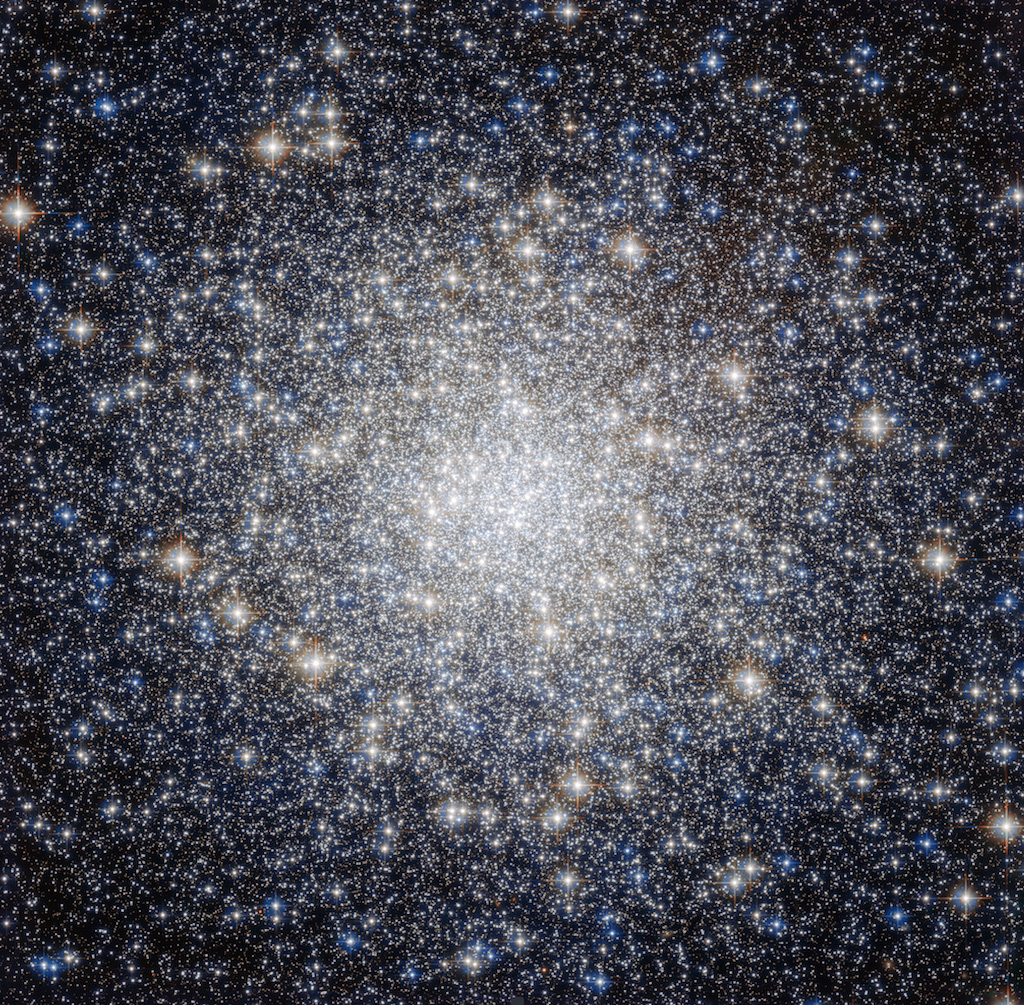1st super-fast pulsar found snacking on its companion in far-flung star cluster

China's Five-hundred-meter Aperture Spherical Telescope (FAST) has uncovered the first known pulsar in Messier 92, a globular star cluster roughly 27,000 light-years away from Earth in the constellation of Hercules.
The swiftly spinning and pulsating object, which goes by two names — PSR J1717+4307A and M92A — forms one part of an eclipsing binary system in which it is siphoning material from a stellar companion, according to the new study.
A research team led by Zhichen Pan and Li Di from the National Astronomical Observatories of the Chinese Academy of Sciences (NAOC), which operates FAST — the world's largest radio telescope — has shown that M92A spins at a rapid speed of 316.5 rotations per second and co-orbits a star lighter than our sun, weighing in at 0.18 solar masses.
Related: Pulsars in nearby globular cluster shed light on Milky Way evolution

Using FAST, the researchers observed two eclipsing events in the binary system, when one object passed in front of the other from Earth's point of view. One eclipse lasted around 5,000 seconds, and the second, which arrived between 1,000 and 2,000 seconds later, lasted for 500 seconds, according to the study. M92A is known as a millisecond pulsar, a souped-up version of the slightly slower-moving pulsar.
Millisecond pulsars are highly-magnetized neutron stars, which pirouette rapidly at speeds less than 30 milliseconds, according to the Swinburne Astronomy Online Encyclopedia of Astronomy.
Ever since the discovery of the very first pulsar in 1967 by astronomer Jocelyn Bell Burnell, then a graduate student at the University of Cambridge, astronomers have uncovered thousands of these stellar speedsters in the Milky Way alone, with some clustering in the galactic plane — the region where the majority of a disk galaxy's mass lies — and others taking residence in the globular clusters that orbit our galaxy's center.
Sign up for the Live Science daily newsletter now
Get the world’s most fascinating discoveries delivered straight to your inbox.
Ordinary pulsars spring into existence at the end of a massive star's life, peaking as a supernova explosion that leaves behind a stellar corpse known as a neutron star in its dusty wake. These neutron stars are small, weighing in at a mass that's equivalent to anywhere from one to several suns, crammed into a diameter of a mere 12.4 to 14.9 miles (20 to 24 kilometers). Yet what they lack in size, they make up for in speed, completing several rotations per second.
If there is a magnetic field lurking around the neutron star, charged particles coming from the star itself become snagged, causing the star to blast electromagnetic radiation in a lighthouse-like beam every few seconds or less. These flashing, magnetic neutron stars are known as pulsars.
Millisecond pulsars, however, move much more quickly, powering hundreds of rotations per second by chewing on gas from a companion star that survived the supernova explosion, spilling material into a disk around the neutron star before falling onto it. During this process, the system is visible as an X-ray binary, according to the National Radio Astronomy Observatory. The neutron star then emerges as a millisecond radio pulsar when the accretion is over.
In globular clusters like Messier 92, things work a bit differently — stars are so tightly packed together that it's easier for ancient neutron stars to interact with other stars, allowing normal stellar binaries to be made. In the case of M92A, the pulsar hasn't found it too difficult to siphon material from its stellar companion, earning itself the reputation of being likened to a "redback spider" — a highly venomous Australian arachnid that often eats their male companions, the researchers said in a statement.
Also known as Tianyan, FAST is located in the Dawodang depression, a natural groove in the land of Pingtang County in southwest China's Guizhou. And this isn't the great radio telescope's first encounter with M92A, its 1,640-foot (500 meters) dish found tantalizing evidence for the pulsar on Oct. 9, 2017 — and with a light-collecting area that's twice that of the Arecibo Observatory in Puerto Rico, it's expected that FAST will improve our understanding of the pulsars that are kicking around the Milky Way galaxy, the researchers said in the statement.
The research was published March 19 in The Astrophysical Journal Letters.
- Pulsars in nearby globular cluster shed light on Milky Way evolution
- First map of a pulsar's surface reveals 'hotspots' in unexpected places
- 30 'homeless' binary stars spotted drifting in the void
Gemma Lavender is the author of Quantum Physics in Minutes (Quercus, 2017) and Haynes Owner's Workshop Manual: Milky Way (Haynes Publishing, 2019), among other books. Follow her on Twitter @Gemma_Lavender. Follow us on Twitter @Spacedotcom and on Facebook.
OFFER: Save 45% on 'All About Space' 'How it Works' and 'All About History'!
For a limited time, you can take out a digital subscription to any of our best-selling science magazines for just $2.38 per month, or 45% off the standard price for the first three months.

Gemma was the former content director of Live Science, Space.com, science and space magazines How It Works and All About Space, history magazines All About History and History of War. She is the author of several books including "Quantum Physics in Minutes", "Haynes Owners’ Workshop Manual to the Large Hadron Collider" and "Haynes Owners’ Workshop Manual to the Milky Way". She holds a degree in physical sciences, a master’s in astrophysics and a PhD in computational astrophysics.












